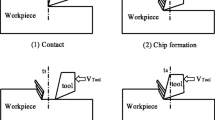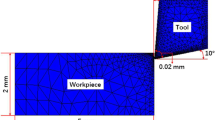Abstract
The ultrasonic-assisted machining (UAM) technique has been widely used in machining of difficult-to-cut materials for its well comprehensive performance, especially in the mechanical and thermal aspects. In this paper, a nonuniform moving heat source model is proposed to analyze the heat transfer problem during ultrasonic vibration-assisted machining of Ti6Al4V. The influences of ultrasonic vibration amplitude and frequency on temperature distribution are discussed in detail. Two main characteristics are observed according to the temperature contours caused by the ultrasonic-assisted machining: one is that the equivalent heat source center tends to move backward the tool rake face, and the other is that the temperature gradients in cutting direction and depth direction are inconsistent. For further study, the temperature variation with respect to vibration parameters near the shear plane and machined surface is calculated. Results show that the increase of vibration amplitude and frequency can reduce the temperature near the shear plane due to a large temperature gradient. Besides, a large vibration amplitude can obtain a low temperature on the machined surface while the increased vibration frequency results in a higher surface temperature after machining. The research can be used to provide guidance for improving the quality and efficiency of difficult-to-cut material machining.
Similar content being viewed by others
References
Dandekar CR, Shin YC, Barnes J (2010) Machinability improvement of titanium alloy (Ti–6Al–4V) via LAM and hybrid machining. Int J Mach Tool Manu 50:174–182
Urbicaina G, Palacios JA, Fernández A, Rodríguez A, López de Lacalle LN, Elías-Zúñiga A (2013) Stability prediction maps in turning of difficult-to-cut materials. Procedia Engineering 63:514–522
Li Z, Zhang DY, Jiang XG, Qin W, Geng DX (2017) Study on rotary ultrasonic-assisted drilling of titanium alloys (Ti6Al4V) using 8-facet drill under no cooling condition. Int J Adv Manuf Technol 90(9–12):3249–3264
Pujana J, Rivero A, Celaya A, López de Lacalle LN (2009) Analysis of ultrasonic-assisted drilling of Ti6Al4V. Int J Mach Tool Manu 49:500–508
Machai C, Biermann D (2011) Machining of β-titanium-alloy Ti–10V–2Fe–3Al under cryogenic conditions: cooling with carbon dioxide snow. J Mater Process Tech 211:1175–1183
Yashiro T, Ogawa T, Sasahara H (2013) Temperature measurement of cutting tool and machined surface layer in milling of CFRP. Int J Mach Tool Manu 70(4):63–69
Guo C, Wu Y, Vargheseb V, Malkin S (1999) Temperatures and energy partition for grinding with vitrified CBN wheels. CIRP Ann—Manuf Techn 48(1):247–250
Zhang XF, Lin B, Xi H (2013) Validation of an analytical model for grinding temperatures in surface grinding by cup wheel with numerical and experimental results. Int J Heat Mass Tran 58:29–42
Muhammad R, Maurotto A, Demiral M, Roy A, Silberschmidt VV (2014) Thermally enhanced ultrasonically assisted machining of Ti alloy. CIRP—J Manuf Sci Tech 7:159–167
Zhang X, Lu Z, Peng Z, Sui H, Zhang D (2018) Development of a tool-workpiece thermocouple system for comparative study of the cutting temperature when high-speed ultrasonic vibration cutting Ti-6Al-4V alloys with and without cutting fluids. Int J Adv Manuf Technol 96(1–4):237–246
Salonitis K, Chryssolouris G (2007) Cooling in grind-hardening operations. Int J Adv Manuf Technol 33(3–4):285–297
Venkatachalapathy VSK, Rajmohan B (2003) Experimental studies on the grind-hardening effect in cylindrical grinding. Mater Manuf Process 18(2):245–259
Nguyen T, Zhang LC (2010) Grinding–hardening using dry air and liquid nitrogen: prediction and verification of temperature fields and hardened layer thickness. Int J Mach Tool Manu 50(10):901–910
Hou ZB, Komanduri R (2000) General solutions for stationary/moving plane heat source problems in manufacturing and tribology. Int J Heat Mass Tran 43:1679–1698
Zhang YW, Faghri A (1996) An integral approximate solution of heat transfer in the grinding process. Int J Heat Mass Tran 39:2653–2662
Jin T, Cai GQ (2000) Analytical thermal models of oblique moving heat source for deep grinding and cutting. J Manuf Sci E 123:185–190
Kidawa-Kukla J (2008) Temperature distribution in a rectangular plate heated by a moving heat source. Int J Heat Mass Tran 51:865–872
Parkitny R, Winczek J (2013) Analytical solution of temporary temperature field in half-infinite body caused by moving tilted volumetric heat source. Int J Heat Mass Tran 60:469–479
Van Elsen M, Baelmans M, Mercelis P, Kruth JP (2007) Solutions for modelling moving heat sources in a semi-infinite medium and applications to laser material processing. Int J Heat Mass Tran 50:4872–4882
Reséndiz-Flores EO, Saucedo-Zendejo FR (2015) Two-dimensional numerical simulation of heat transfer with moving heat source in welding using the Finite Pointset Method. Int J Heat Mass Tran 90:239–245
Foeckerer T, Zaeh MF, Zhang OB (2013) A three-dimensional analytical model to predict the thermo-metallurgical effects within the surface layer during grinding and grind-hardening. Int J Heat Mass Tran 56:223–237
Devesse W, De Baere D, Guillaume P (2014) The isotherm migration method in spherical coordinates with a moving heat source. Int J Heat Mass Tran 75:726–735
Mitrofanov AV, Babitsky VI, Silberschmidt VV (2004) Finite element analysis of ultrasonically assisted turning of Inconel 718. J Mater Process Tech 153-154:233–239
Mitrofanov AV, Babitsky VI, Silberschmidt VV (2005) Thermomechanical finite element simulations of ultrasonically assisted turning. Comput Mater Sci 32:463–471
Ahmed N, Mitrofanov AV, Babitsky VI, Silberschmidt VV (2006) Analysis of material response to ultrasonic vibration loading in turning Inconel 718. Mater Sci Eng A 424:318–325
Ahmed N, Mitrofanov AV, Babitsky VI, Silberschmidt VV (2007) Analysis of forces in ultrasonically assisted turning. J Sound Vib 308:845–854
Overcash JL, Cuttino JF (2009) In-process modeling of dynamic tool-tip temperatures of a tunable vibration turning device operating at ultrasonic frequencies. Precis Eng 33:505–515
Elangovan S, Semeer S, Prakasan K (2009) Temperature and stress distribution in ultrasonic metal welding—an FEA-based study. J Mater Process Tech 209:1143–1150
Patil S, Joshi S, Tewari A, Joshi SS (2014) Modelling and simulation of effect of ultrasonic vibrations on machining of Ti6Al4V. Ultrasonics 54:694–705
Zhu Z, Wynne BP, Ghassemieh E (2008) Microstrcutural evolution of SiC fibre embedded AA6061 matrix induced by ultrasonic consolidation. MRS Proc 1075
Özel T (2006) The influence of friction models on finite element simulations of machining. Int J Mach Tool Manu 46(5):518–530
Teidelt E, Starcevic J, Popov VL (2012) Influence of ultrasonic oscillation on static and sliding friction. Tribol Lett 48:51–62
Arcona C, Dow TA (1996) A new technique for studying the chip formation process in diamond turning. Precis Eng 18(2–3):157–160
Komanduri R, Hou ZB (2001) Thermal modeling of the metal cutting process—part III: temperature rise distribution due to the combined effects of shear plane heat source and the tool–chip interface frictional heat source. Int J Mech Sci 43(1):89–107
Komanduri R, Hou ZB (2000) Thermal modeling of the metal cutting process: part I—temperature rise distribution due to shear plane heat source. Int J Mech Sci 42(9):1715–1752
Hahn RS (1951) On the temperature developed at the shear plane in the metal cutting process. Proceedings of First U.S. National Congress of Applied Mechanics, 661–666
Wu Z, Deng JX, Chen Y, Xing YQ, Zhao J (2012) Performance of the self-lubricating textured tools in dry cutting of Ti-6Al-4V. Int J Adv Manuf Technol 62:943–951
Shaw MC (1984) Metal cutting principles. Oxford U.K. Oxford University Press
Chen JB, Fang QH, Wang CC, Du JK, Liu F (2016) Theoretical study on brittle–ductile transition behavior in elliptical ultrasonic assisted grinding of hard brittle materials. Precis Eng 46:104–117
Gente A, Hoffmeister HW, Evans CJ (2001) Chip formation in machining Ti6Al4V at extremely high cutting speeds. CIRP Ann-Manuf Techn 50(1):49–52
Liu K, Li XP, Liang SY (2007) The mechanism of ductile chip formation in cutting of brittle materials. Int J Adv Manuf Technol 33(9–10):875–884
Lee P, Altintaş Y (1996) Prediction of ball-end milling forces from orthogonal cutting data. Int J Mach Tool Manu 36(9):1059–1072
Li S, Wu Y, Nomura M (2016) Effect of grinding wheel ultrasonic vibration on chip formation in surface grinding of Inconel 718. Int J Adv Manuf Technol 86(1–4):1113–1125
Wu YB, Nomura M, Zhi JF, Kato M (2004) Modeling of grinding force in constant-depth-of-cut ultrasonically assisted grinding. Mater Sci Forum 471-472:101–106
Bouacha K, Yallese MA, Mabrouki T, Rigal JF (2010) Statistical analysis of surface roughness and cutting forces using response surface methodology in hard turning of AISI 52100 bearing steel with CBN tool. Int J Refract Met H 28(3):349–361
Funding
The authors would like to deeply appreciate the support from the National Natural Science Foundation of China (51601100, 11672141, 11572118, and 11402128), the Programs Supported by Ningbo Natural Science Foundation (2017A610092), the Hunan Provincial Science Fund for Distinguished Young Scholars (2015JJ1006), the Fok Ying-Tong Education Foundation, China (141005), and the K. C. Wong Magna Fund administered by Ningbo University.
Author information
Authors and Affiliations
Corresponding authors
Rights and permissions
About this article
Cite this article
Chen, J., Xu, M., Xie, C. et al. A nonuniform moving heat source model for temperature simulation in ultrasonic-assisted cutting of titanium alloys. Int J Adv Manuf Technol 97, 3009–3021 (2018). https://doi.org/10.1007/s00170-018-2174-8
Received:
Accepted:
Published:
Issue Date:
DOI: https://doi.org/10.1007/s00170-018-2174-8




